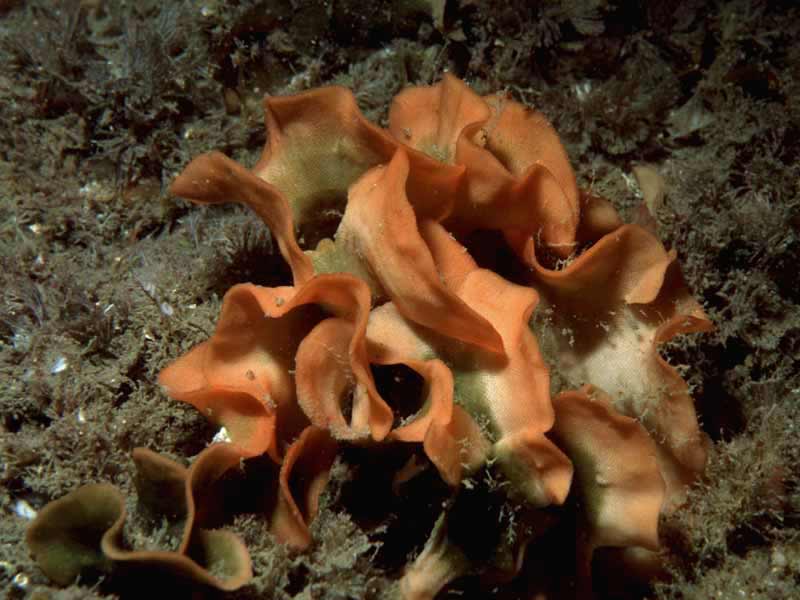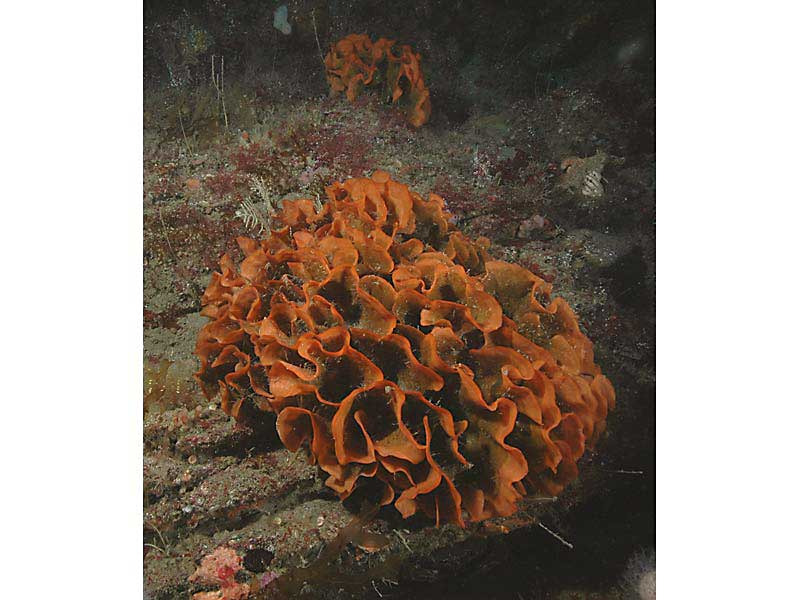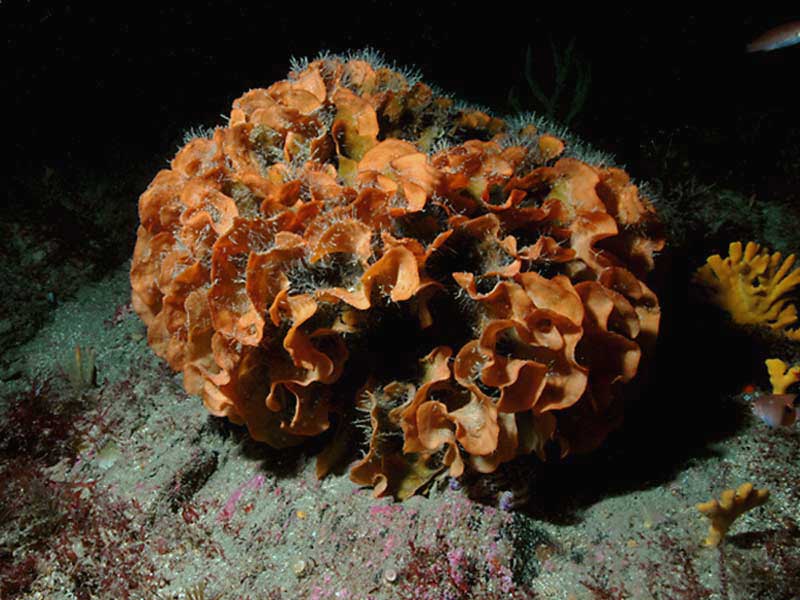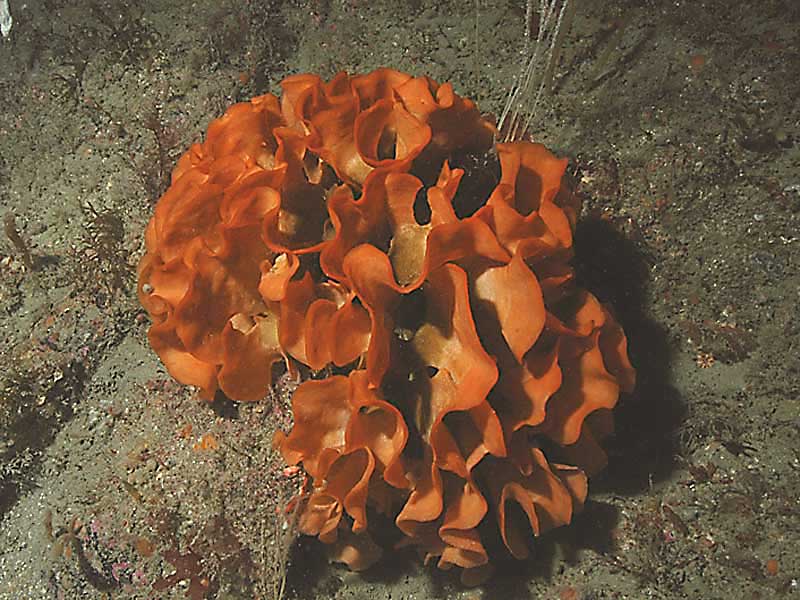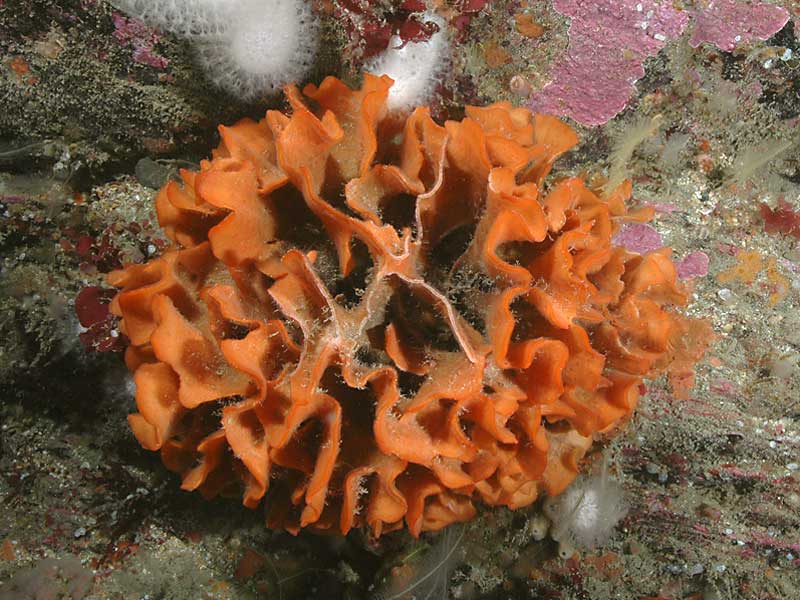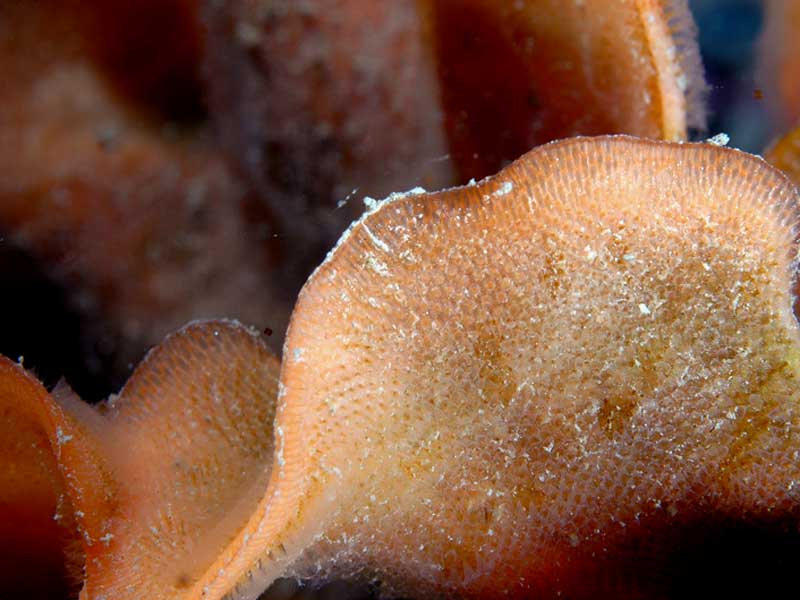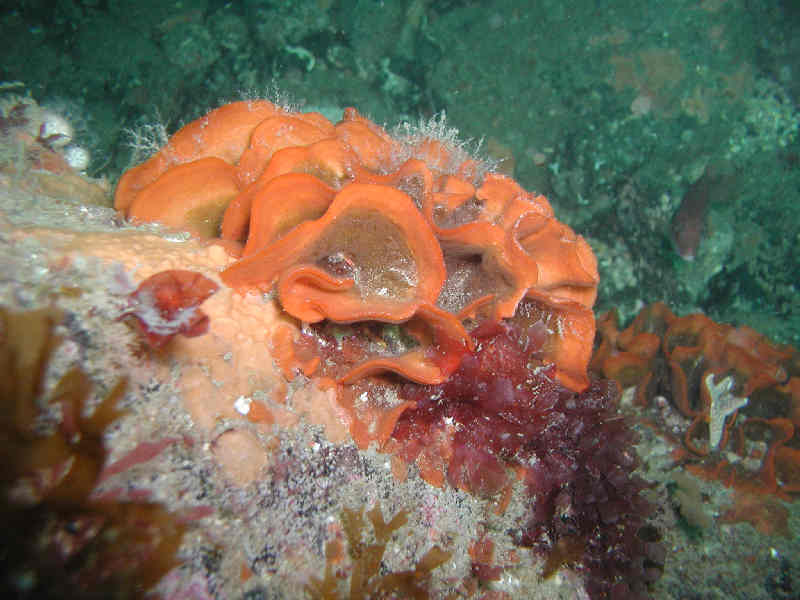Ross (Pentapora foliacea)
Distribution data supplied by the Ocean Biodiversity Information System (OBIS). To interrogate UK data visit the NBN Atlas.Map Help
| Researched by | Angus Jackson | Refereed by | Dr Peter J. Hayward |
| Authority | (Ellis & Solander, 1786) | ||
| Other common names | - | Synonyms | Pentapora fascialis (Pallas 1766), Lepralia foliacea (Ellis & Solander, 1786) |
Summary
Description
A large, erect bryozoan deep orange in colour. The colony is attached to the substratum by an encrusting base and forms a mass of repeatedly dividing sheets in an open honeycomb structure. The edges of the sheets are wavy and convoluted. Pentapora foliacea has a growth rate of approximately 2 cm per year and lives for up to ten years. Colonies can reach up to 40 cm in diameter (more typically up to 20 cm across) and 10 cm in height. When dead, the deep orange colour fades to a pale buff.
Recorded distribution in Britain and Ireland
Common along the South coast of England as far east as Beachy Head. Also the south west, the western extremities of Wales and the Isle of Man. In Ireland present along the south west and north coasts. Scarce records from the Hebrides and St Kilda.
Global distribution
Pentapora foliacea is also recorded from the north coast of Morocco, but Mediterranean records require reassessment based on recent taxonomy (Lombardi et al., 2010).
Habitat
Pentapora foliacea colonies grow on bedrock or large boulders in current swept areas, often surrounded by gravel and scoured by coarse sand. They may colonize coarse gravel and pebbles but do not grow to large colonies.
Depth range
11 - 80Identifying features
- Colonies erect, forming orange-buff clumps up to about 15 cm across.
- Young zooids elongate-hexagonal, with scattered pores in frontal wall.
- Frontal wall covered with heavy additional calcification, outline becoming rectangular or broadly hexagonal.
Additional information
Sometimes misleadingly called "ross coral". The Species Directory of the British Isles (Howson & Picton, 1997) placed Pentapora fascialis in the family Hippoporinidae under the species name Pentapora foliacea but Hayward & Ryland (1999) conflated the species and suggested that Pentapora foliacea was a junior synonym of Pentapora fascialis (Lombardi et al., 2010). Older classification schemes used the species Lepralia foliacea, e.g. the Plymouth Marine Fauna (Marine Biological Association, 1957) and Bruce et al. (1963). But a recent study by Lombardi et al. (2010) concluded that Pentapora foliacea and Pentpora fascialis were distinct species and that Pentapora foliacea was the resident species in the North East Atlantic while Pentapora fascialis was included in the Mediterranean clade. Due to the lack of information on these species and the taxonomic confusion in the literature, this review is based on information on both Pentapora foliacea and Pentapora fascialis.
Listed by
Biology review
Taxonomy
| Level | Scientific name | Common name |
|---|---|---|
| Phylum | Bryozoa | Sea mats, horn wrack & lace corals |
| Class | Gymnolaemata | Naked throat bryozoans |
| Order | Cheilostomatida | |
| Family | Bitectiporidae | |
| Genus | Pentapora | |
| Authority | (Ellis & Solander, 1786) | |
| Recent Synonyms | Pentapora fascialis (Pallas 1766)Lepralia foliacea (Ellis & Solander, 1786) | |
Biology
| Parameter | Data | ||
|---|---|---|---|
| Typical abundance | Moderate density | ||
| Male size range | |||
| Male size at maturity | |||
| Female size range | Medium-large(21-50cm) | ||
| Female size at maturity | |||
| Growth form | Foliose | ||
| Growth rate | 2 cm/year | ||
| Body flexibility | None (less than 10 degrees) | ||
| Mobility | Sessile, permanent attachment | ||
| Characteristic feeding method | Active suspension feeder | ||
| Diet/food source | |||
| Typically feeds on | |||
| Sociability | |||
| Environmental position | Epibenthic | ||
| Dependency | No text entered. | ||
| Supports | Substratum A variety of bryozoan species, and other epibionts. | ||
| Is the species harmful? | No | ||
Biology information
- Densities in the Bristol Channel have been recorded as up to one large colony per square metre. Populations in the Mediterranean have been recorded at densities of up to 7 colonies per square metre.
- Pentapora fascialis grows initially as an encrusting sheet, which seems able to regenerate erect growths (P.J. Hayward pers. comm.).
- Size ranges refer to colony diameter. Colony size is typically up to 20 cm in diameter and large specimens reach 40 cm across. The largest recorded specimen was from the Eddystone Light and had a circumference of over two metres and a depth of 30 cm (Hayward & Ryland, 1979). Specimens of Pentapora fascialis in the Mediterranean reach larger sizes (80cm diameter, 50 cm in height) in deeper waters (40-80 m).
- Colony shape has been described as 'depressed globular' or 'dome-like' with an elliptical perimeter (Cocito et al., 1998(a)). Growth rates in the Bristol Channel have been estimated at around 2 cm (vertical height) per year through the use of stable oxygen isotope values (Patzold et al., 1987.). Another growth rate estimate (from the Mediterranean) indicates growth of over 200% colony surface area in 11 months (Cocito et al., 1998). Vertical growth has been recorded at up to 3.5 cm per year (Cocito & Ferdeghini, 1998 cited in Cocito et al., 1998).
- The calcified laminae are rather brittle.
- Pentapora fascialis characteristically supports several bryozoans including Amphiblestrum flemingii, Callopora dumerilii, Membranipora nitida & Smittoidea reticulata (Hayward & Ryland, 1979). Large colonies may shelter thousands of other animals (Hayward & Ryland, 1979).
Habitat preferences
| Parameter | Data |
|---|---|
| Physiographic preferences | Offshore seabed, Open coast |
| Biological zone preferences | Lower circalittoral, Lower infralittoral, Upper circalittoral |
| Substratum / habitat preferences | Artificial (man-made), Bedrock, Large to very large boulders |
| Tidal strength preferences | Moderately strong 1 to 3 knots (0.5-1.5 m/sec.), Strong 3 to 6 knots (1.5-3 m/sec.) |
| Wave exposure preferences | Exposed, Moderately exposed, Sheltered, Very exposed |
| Salinity preferences | Full (30-40 psu) |
| Depth range | 11 - 80 |
| Other preferences | No text entered |
| Migration Pattern | Non-migratory or resident |
Habitat Information
Off Lundy in the Bristol Channel, most common below 18 m and abundant between 25 -34 m (Hayward & Ryland, 1979). Pentapora fascialis is recorded as settling on artificial substrata in the Ligurian sea (Geraci, 1974 cited in Cocito et al., 1998(b)). Pentapora foliacea is recorded as being present (off the British Isles) in temperatures between 8 & 14 °C and salinity of 34.5 psu (Patzold et al., 1987).
Life history
Adult characteristics
| Parameter | Data |
|---|---|
| Reproductive type | No information |
| Reproductive frequency | Annual protracted |
| Fecundity (number of eggs) | No information |
| Generation time | Insufficient information |
| Age at maturity | See additional information |
| Season | February - October |
| Life span | 5-10 years |
Larval characteristics
| Parameter | Data |
|---|---|
| Larval/propagule type | - |
| Larval/juvenile development | Lecithotrophic |
| Duration of larval stage | < 1 day |
| Larval dispersal potential | No information |
| Larval settlement period | Insufficient information |
Life history information
Pentapora foliacea and Pentapora fascialis are closely related. Therefore, information from Pentapora fascialis has been used to infer life history characteristics of Pentapora foliacea due to the lack of species-specific information and the confusion in taxonomy between the two species.
- Pentapora foliacea is perennial (Eggleston, 1972a) and probably lives for several years. Stable oxygen isotope values have shown colonies to be at least 3 years old (Patzold et al., 1987) and other estimates of growth rate suggest that Pentapora fascialis colonies in the Mediterranean are 10 years old or more (Cocito et al., 1998(a)).
- In Pentapora fascialis, the presence/absence of ovicells is taken to be a reliable indicator of reproductive status and as such is a feature of sexual maturity (Cocito et al., 1998(b)). In the Skomer Marine Nature Reserve, Pentapora foliacea colonies were reported to have ovicells present in September, indicating a reproduction event in September or late August (Lock et al., 2006). Colonies of Pentapora fascialis as small as 2.8 cm have been recorded as having ovicells. Reproductive ability is gained at an early stage of colony development (Cocito et al., 1998(b)). Larval settling time is inferred from another Cheilostomata bryozoan species, Bugula neritina (Keough & Chernoff, 1987). Gautier (1962) records ovicells being present all year round. Cocito et al. (1998(b)) note the presence of ovicells in Pentapora fascialis in the northwestern Mediterranean from February to October.
- Patzold et al. (1987) record the formation of a growth band in Pentapora foliacea during times of reduced reproductivity. This growth check line appears during periods of colder water temperatures.
Sensitivity review
The MarLIN sensitivity assessment approach used below has been superseded by the MarESA (Marine Evidence-based Sensitivity Assessment) approach (see menu). The MarLIN approach was used for assessments from 1999-2010. The MarESA approach reflects the recent conservation imperatives and terminology and is used for sensitivity assessments from 2014 onwards.
Physical pressures
Use / to open/close text displayed
| Intolerance | Recoverability | Sensitivity | Evidence / Confidence | |
Substratum loss [Show more]Substratum lossBenchmark. All of the substratum occupied by the species or biotope under consideration is removed. A single event is assumed for sensitivity assessment. Once the activity or event has stopped (or between regular events) suitable substratum remains or is deposited. Species or community recovery assumes that the substratum within the habitat preferences of the original species or community is present. Further details EvidencePentapora foliacea is permanently attached to the seabed so substratum loss would result in death. Although being quite long-lived (10+ years) Pentapora fascialis is noted as having good reproductive and recolonization abilities, quite fast growth rates and gaining reproductive competency at an early stage (Cocito et al., 1998(b)). However, as the larval stage is potentially very short lived, dispersal distances may be limited (Keough & Chernoff, 1987). Local position of the adults can strongly affect the spatial pattern of larval settlement (Cocito et al 1998(b)). Following the almost total loss of a small population, Cocito et al., 1998(b)) recorded recovery and growth to original colony sizes taking only 3.5 years. In this case, reproductive adults remained nearby. If there are no remaining nearby adult populations then recovery may take much longer and so is assessed as moderate. | High | Moderate | Moderate | High |
Smothering [Show more]SmotheringBenchmark. All of the population of a species or an area of a biotope is smothered by sediment to a depth of 5 cm above the substratum for one month. Impermeable materials, such as concrete, oil, or tar, are likely to have a greater effect. Further details. EvidencePentapora foliacea is permanently attached to the seabed and so would be unable to avoid smothering. Although colonies of this species may reach considerable heights (50 cm in the Mediterranean), the sheet-like-structure is likely to retain any smothering sediment. Smaller colonies may be entirely killed whereas larger colonies that protrude through the smothering layer may lose only part of the colony. Smothering by encrusting epibiotic species may also occur (Cocoito et al. (1998(a)) recorded epibionts present on 50 % of the area of study quadrats in the Mediterranean). Epibionts can cause partial mortality of colonies. This effect is size dependent - proportions affected by epibionts is greater in larger colonies. Although being quite long-lived (10+ years) Pentapora fascialis is noted as having good reproductive and recolonization abilities, quite fast growth rates and gaining reproductive competency at an early stage (Cocito et al., 1998(b)). However, as the larval stage is potentially very short lived, dispersal distances may be limited (Keough & Chernoff, 1987). Local position of the adults can strongly affect the spatial pattern of larval settlement (Cocito et al 1998(b)). Following the almost total loss of a small population, Cocito et al., 1998(b)) recorded recovery and growth to original colony sizes taking only 3.5 years. In this case, reproductive adults remained nearby. If there are no remaining nearby adult populations then recovery may take much longer. Some evidence is available regarding the ability of this species to repair damage to colonies by epibiont smothering by regrowth of new zooids and strengthening of the base by thickening of lower zooid walls (Hayward and Ryland, 1979). | Intermediate | Moderate | Moderate | Moderate |
Increase in suspended sediment [Show more]Increase in suspended sedimentBenchmark. An arbitrary short-term, acute change in background suspended sediment concentration e.g., a change of 100 mg/l for one month. The resultant light attenuation effects are addressed under turbidity, and the effects of rapid settling out of suspended sediment are addressed under smothering. Further details EvidenceSiltation has been recorded as causing partial colony mortality in populations of Pentapora fascialis in the Mediterranean. Increases in siltation rate may cause loss of part of a population. Although being quite long-lived (10+ years) Pentapora fascialis is noted as having good reproductive and recolonization abilities, quite fast growth rates and gaining reproductive competency at an early stage (Cocito et al., 1998(b)). However, as the larval stage is potentially very short lived, dispersal distances may be limited (Keough & Chernoff, 1987). Local position of the adults can strongly affect the spatial pattern of larval settlement (Cocito et al., 1998(b)). Following the almost total loss of a small population, Cocito et al., 1998(b)) recorded recovery and growth to original colony sizes taking only 3.5 years. In this case, reproductive adults remained nearby. If there are no remaining nearby adult populations then recovery may take much longer. Some evidence is available regarding the ability of this species to repair damage to colonies by siltation by regrowth of new zooids and strengthening of the base by thickening of lower zooid walls (Hayward and Ryland, 1979). | Intermediate | High | Low | Moderate |
Decrease in suspended sediment [Show more]Decrease in suspended sedimentBenchmark. An arbitrary short-term, acute change in background suspended sediment concentration e.g., a change of 100 mg/l for one month. The resultant light attenuation effects are addressed under turbidity, and the effects of rapid settling out of suspended sediment are addressed under smothering. Further details Evidence | No information | |||
Desiccation [Show more]Desiccation
EvidenceThe species is entirely subtidal and exposure to desiccating influences is likely to cause death. Although being quite long-lived (10+ years) Pentapora fascialis is noted as having good reproductive and recolonization abilities, quite fast growth rates and gaining reproductive competency at an early stage (Cocito et al., 1998(b)). However, as the larval stage is potentially very short lived, dispersal distances may be limited (Keough & Chernoff, 1987). Local position of the adults can strongly affect the spatial pattern of larval settlement (Cocito et al., 1998(b)). Following the almost total loss of a small population, Cocito et al., 1998(b)) recorded recovery and growth to original colony sizes taking only 3.5 years. In this case, reproductive adults remained nearby. If there are no remaining nearby adult populations then recovery may take much longer and so is assessed as moderate. | High | Moderate | Moderate | Low |
Increase in emergence regime [Show more]Increase in emergence regimeBenchmark. A one hour change in the time covered or not covered by the sea for a period of one year. Further details EvidenceThe species is entirely subtidal and a period of emergence is likely to cause death. Although being quite long-lived (10+ years) Pentapora fascialis is noted as having good reproductive and recolonization abilities, quite fast growth rates and gaining reproductive competency at an early stage (Cocito et al., 1998(b)). However, as the larval stage is potentially very short lived, dispersal distances may be limited (Keough & Chernoff, 1987). Local position of the adults can strongly affect the spatial pattern of larval settlement (Cocito et al., 1998(b)). Following almost total loss of a small population, Cocito et al., 1998(b)) recorded recovery and growth to original colony sizes taking only 3.5 years. In this case, reproductive adults remained nearby. If there are no remaining nearby adult populations then recovery may take much longer. | High | Moderate | Moderate | Low |
Decrease in emergence regime [Show more]Decrease in emergence regimeBenchmark. A one hour change in the time covered or not covered by the sea for a period of one year. Further details Evidence | No information | |||
Increase in water flow rate [Show more]Increase in water flow rateA change of two categories in water flow rate (view glossary) for 1 year, for example, from moderately strong (1-3 knots) to very weak (negligible). Further details EvidenceThe species inhabits environments with considerable water flow and is often found in areas scoured by sand. Decreases in water flow rate may interfere with feeding efficiency. Recovery of condition on the resumption of normal conditions should not take too long. | Low | Very high | Very Low | Low |
Decrease in water flow rate [Show more]Decrease in water flow rateA change of two categories in water flow rate (view glossary) for 1 year, for example, from moderately strong (1-3 knots) to very weak (negligible). Further details Evidence | No information | |||
Increase in temperature [Show more]Increase in temperature
For intertidal species or communities, the range of temperatures includes the air temperature regime for that species or community. Further details EvidencePentapora foliacea is found in warmer waters as far south the north coast of Morocco. The northernmost limits of the distribution are in the Minch off western Scotland. Once established, colonies are most likely able to withstand occasional lower or higher than normal temperatures, but long term decreases in temperature may cause distribution range to shrink. Although being quite long-lived (10+ years) Pentapora fascialis is noted as having good reproductive and recolonization abilities, quite fast growth rates and gaining reproductive competency at an early stage (Cocito et al., 1998(b)). However, as the larval stage is potentially very short lived, dispersal distances may be limited (Keough & Chernoff, 1987). Local position of the adults can strongly affect the spatial pattern of larval settlement (Cocito et al., 1998(b)). Following the almost total loss of a small population, Cocito et al., 1998(b)) recorded recovery and growth to original colony sizes taking only 3.5 years. In this case, reproductive adults remained nearby. If there are no remaining nearby adult populations then recovery may take much longer. Some evidence is available regarding the ability of this species to repair damage to the colony by regrowth of new zooids and strengthening of the base by thickening of lower zooid walls (Hayward and Ryland, 1979). | Intermediate | High | Low | Low |
Decrease in temperature [Show more]Decrease in temperature
For intertidal species or communities, the range of temperatures includes the air temperature regime for that species or community. Further details Evidence | No information | |||
Increase in turbidity [Show more]Increase in turbidity
EvidenceThe species has very low or no ability for visual perception and is unlikely to be sensitive to changes in turbidity. | Tolerant | Not relevant | Not sensitive | High |
Decrease in turbidity [Show more]Decrease in turbidity
Evidence | No information | |||
Increase in wave exposure [Show more]Increase in wave exposureA change of two ranks on the wave exposure scale (view glossary) e.g., from Exposed to Extremely exposed for a period of one year. Further details EvidenceThe species can occur in fairly exposed conditions. However, extreme wave action, as in storms, has been noted to cause widespread destruction of colonies (Cocito et al., 1998(a)). Therefore, increases in wave exposure may cause damage to colonies. Although being quite long-lived (10+ years) Pentapora fascialis is noted as having good reproductive and recolonization abilities, quite fast growth rates and gaining reproductive competency at an early stage (Cocito et al., 1998(b)). However, as the larval stage is potentially very short lived, dispersal distances may be limited (Keough & Chernoff, 1987). Local position of the adults can strongly affect the spatial pattern of larval settlement (Cocito et al., 1998(b)). Following the almost total loss of a small population, Cocito et al. (1998(b)) recorded recovery and growth to original colony sizes taking only 3.5 years. In this case, reproductive adults remained nearby. If there are no remaining nearby adult populations then recovery may take much longer. Some evidence is available regarding the ability of this species to repair damage to the colony by regrowth of new zooids and strengthening of the base by thickening of lower zooid walls (Hayward and Ryland, 1979). | Intermediate | High | Low | Moderate |
Decrease in wave exposure [Show more]Decrease in wave exposureA change of two ranks on the wave exposure scale (view glossary) e.g., from Exposed to Extremely exposed for a period of one year. Further details Evidence | No information | |||
Noise [Show more]Noise
EvidenceIt is unlikely that Pentapora fascialis has a particular intolerance to noise vibrations. | Tolerant | Not relevant | Not sensitive | Low |
Visual presence [Show more]Visual presenceBenchmark. The continuous presence for one month of moving objects not naturally found in the marine environment (e.g., boats, machinery, and humans) within the visual envelope of the species or community under consideration. Further details EvidenceThe species has very low or no ability for visual perception and is unlikely to be sensitive to changes in visual perception. | Tolerant | Not relevant | Not sensitive | High |
Abrasion & physical disturbance [Show more]Abrasion & physical disturbanceBenchmark. Force equivalent to a standard scallop dredge landing on or being dragged across the organism. A single event is assumed for assessment. This factor includes mechanical interference, crushing, physical blows against, or rubbing and erosion of the organism or habitat of interest. Where trampling is relevant, the evidence and trampling intensity will be reported in the rationale. Further details. EvidenceThe 'leaves' of a Pentapora foliacea colony are highly calcified and brittle. Physical abrasion can easily cause damage. Pentapora foliacea is noted as being tolerant of regular medium intensity disturbances (such as winter storms) but low frequency, high intensity disturbances such as freak storms cause mortality, particularly in shallower waters (Cocito et al., 1998(b)). The effects of diver frequentation have been monitored for Pentapora fascialis populations in the Mediterranean (Sala et al., 1996). Areas with heavy diving activity have greatly reduced densities of Pentapora fascialis and remaining colonies are frequently smaller and highly damaged. Colonies only survive in more protected locations such as under overhangs. In addition, Pentapora foliacea was reported to be damaged by scallop dredges and mobile fishing gear, pots and creels (Bullimore, 1985; DWT, 1993; Eno et al., 1996). Mobile gears also result in modification of the substratum, including removal of shell debris, cobbles and rocks, and the movement of boulders (Bullimore, 1985; Jennings & Kaiser, 1998). Therefore, intolerance has been assessed as high. Although being quite long-lived (10+ years) Pentapora fascialis is noted as having good reproductive and recolonization abilities, quite fast growth rates and gaining reproductive competency at an early stage (Cocito et al., 1998b). However, as the larval stage is potentially very short lived, dispersal distances may be limited (Keough & Chernoff, 1987). Local position of the adults can strongly affect the spatial pattern of larval settlement (Cocito et al., 1998b). Following almost total loss of a small population, Cocito et al., 1998b) recorded recovery and growth to original colony sizes taking only 3.5 years. In this case, reproductive adults remained nearby. If there are no remaining nearby adult populations then recovery may take much longer. | High | Moderate | Moderate | High |
Displacement [Show more]DisplacementBenchmark. Removal of the organism from the substratum and displacement from its original position onto a suitable substratum. A single event is assumed for assessment. Further details EvidenceThe colonies of Pentapora fascialis are permanently attached to the substratum. If displaced, the colony in not able to reform the attachment and death occurs. No information is available regarding the reproduction or dispersal abilities of this species so no assessment of recoverability can be made. However, the species may be quite long lived (10+ years) and slow growing (2 cm per year). Following loss of a population, growth to original colony sizes, after recolonization, may take some years. | High | Moderate | Moderate | High |
Chemical pressures
Use [show more] / [show less] to open/close text displayed
| Intolerance | Recoverability | Sensitivity | Evidence / Confidence | |
Synthetic compound contamination [Show more]Synthetic compound contaminationSensitivity is assessed against the available evidence for the effects of contaminants on the species (or closely related species at low confidence) or community of interest. For example:
The evidence used is stated in the rationale. Where the assessment can be based on a known activity then this is stated. The tolerance to contaminants of species of interest will be included in the rationale when available; together with relevant supporting material. Further details. EvidenceInsufficient | No information | No information | No information | Not relevant |
Heavy metal contamination [Show more]Heavy metal contaminationEvidenceInsufficient | No information | No information | No information | Not relevant |
Hydrocarbon contamination [Show more]Hydrocarbon contaminationEvidenceInsufficient | No information | No information | No information | Not relevant |
Radionuclide contamination [Show more]Radionuclide contaminationEvidenceInsufficient | No information | No information | No information | Not relevant |
Changes in nutrient levels [Show more]Changes in nutrient levelsEvidenceInsufficient | No information | No information | No information | Not relevant |
Increase in salinity [Show more]Increase in salinity
EvidenceThe species only inhabits fully saline waters (Patzold et al., 1987) and exposure to salinity conditions outside of this range would probably result in death. Although being quite long-lived (10+ years) Pentapora fascialis is noted as having good reproductive and recolonization abilities, quite fast growth rates and gaining reproductive competency at an early stage (Cocito et al., 1998(b)). However, as the larval stage is potentially very short lived, dispersal distances may be limited (Keough & Chernoff, 1987). Local position of the adults can strongly affect the spatial pattern of larval settlement (Cocito et al., 1998(b)). Following the almost total loss of a small population, Cocito et al., 1998(b)) recorded recovery and growth to original colony sizes taking only 3.5 years. In this case, reproductive adults remained nearby. If there are no remaining nearby adult populations, as is likely with changes in salinity, then recovery may take much longer. | High | Moderate | Moderate | Moderate |
Decrease in salinity [Show more]Decrease in salinity
Evidence | No information | |||
Changes in oxygenation [Show more]Changes in oxygenationBenchmark. Exposure to a dissolved oxygen concentration of 2 mg/l for one week. Further details. EvidenceThere is no information regarding the tolerance of Pentapora fascialis to changes in oxygen concentration. However, Cole et al., (1999) suggest possible adverse effects on marine species below 4 mg/l and probable adverse effects below 2mg/l. Although being quite long-lived (10+ years) Pentapora fascialis is noted as having good reproductive and recolonization abilities, quite fast growth rates and gaining reproductive competency at an early stage (Cocito et al., 1998(b)). However, as the larval stage is potentially very short lived, dispersal distances may be limited (Keough & Chernoff, 1987). Local position of the adults can strongly affect the spatial pattern of larval settlement (Cocito et al., 1998(b)). Following almost total loss of a small population, Cocito et al., 1998(b)) recorded recovery and growth to original colony sizes taking only 3.5 years. In this case, reproductive adults remained nearby. If there are no remaining nearby adult populations then recovery may take much longer. Some evidence is available regarding the ability of this species to repair damage to the colony by regrowth of new zooids and strengthening of the base by thickening of lower zooid walls (Hayward and Ryland, 1979). | Intermediate | High | Low | Low |
Biological pressures
Use [show more] / [show less] to open/close text displayed
| Intolerance | Recoverability | Sensitivity | Evidence / Confidence | |
Introduction of microbial pathogens/parasites [Show more]Introduction of microbial pathogens/parasitesBenchmark. Sensitivity can only be assessed relative to a known, named disease, likely to cause partial loss of a species population or community. Further details. EvidenceInsufficient | No information | No information | No information | Not relevant |
Introduction of non-native species [Show more]Introduction of non-native speciesSensitivity assessed against the likely effect of the introduction of alien or non-native species in Britain or Ireland. Further details. EvidenceInsufficient | No information | No information | No information | Not relevant |
Extraction of this species [Show more]Extraction of this speciesBenchmark. Extraction removes 50% of the species or community from the area under consideration. Sensitivity will be assessed as 'intermediate'. The habitat remains intact or recovers rapidly. Any effects of the extraction process on the habitat itself are addressed under other factors, e.g. displacement, abrasion and physical disturbance, and substratum loss. Further details. EvidenceThe species has no commercial value (Sala et al., 1996) and is highly unlikely to be extracted. | Not relevant | Not relevant | Not relevant | High |
Extraction of other species [Show more]Extraction of other speciesBenchmark. A species that is a required host or prey for the species under consideration (and assuming that no alternative host exists) or a keystone species in a biotope is removed. Any effects of the extraction process on the habitat itself are addressed under other factors, e.g. displacement, abrasion and physical disturbance, and substratum loss. Further details. EvidencePentapora fascialis has no known obligate relationships. Extraction of other species is not likely to have any effect on Pentapora fascialis colonies. | Tolerant | Not relevant | Not sensitive | Very low |
Additional information
Importance review
Policy/legislation
| Designation | Support |
|---|---|
| Northern Ireland Priority Species | Yes |
Status
| National (GB) importance | Not rare or scarce | Global red list (IUCN) category | - |
Non-native
| Parameter | Data |
|---|---|
| Native | - |
| Origin | - |
| Date Arrived | - |
Importance information
On rocky, current swept seabeds, the species is often a conspicuous and dominant component of the assemblage (Hayward & Ryland, 1979.). Pentapora foliacea is recorded as acting as host for a variety of other bryozoan species and shelter for quite high densities of other fauna (Hayward & Ryland, 1979)
Bibliography
Bruce, J.R., Colman, J.S. & Jones, N.S., 1963. Marine fauna of the Isle of Man. Liverpool: Liverpool University Press.
Cocito, S., Ferdeghini, F., & Sgorbini, S., 1998b. Pentapora fascialis (Pallas) [Cheilostomata: Ascophora] colonization of one sublittoral rocky site after sea-storm in the northwest Mediterranean. Hydrobiologia, 375/376, 59-66.
Cocito, S., Sgarbini, S. & Bianchi, C.N., 1998a. Aspects of the biology of the bryozoan Pentapora fascialis in the northwestern Mediterranean. Marine Biology, 131, 73-82.
Eggleston, D., 1972a. Patterns of reproduction in marine Ectoprocta off the Isle of Man. Journal of Natural History, 6, 31-38.
Gautier, Y.V., 1962. Recherches ecologiques sur les bryozoares chilostomes en Mediterranee occidentale. Recueil des travaux de la station marine d'Endoume, 38, 165-166.
Hayward, P., Nelson-Smith, T. & Shields, C. 1996. Collins pocket guide. Sea shore of Britain and northern Europe. London: HarperCollins.
Hayward, P.J. & Ryland, J.S. 1979. British ascophoran bryozoans. London: Academic Press.
Hayward, P.J. & Ryland, J.S. 1999. Cheilostomatous Bryozoa. Part II Hippothooidea - Celleporoidea. London: Academic Press. [Synopses of the British Fauna, no. 14. (2nd edition)]
Howson, C.M. & Picton, B.E., 1997. The species directory of the marine fauna and flora of the British Isles and surrounding seas. Belfast: Ulster Museum. [Ulster Museum publication, no. 276.]
JNCC (Joint Nature Conservation Committee), 1999. Marine Environment Resource Mapping And Information Database (MERMAID): Marine Nature Conservation Review Survey Database. [on-line] http://www.jncc.gov.uk/mermaid
Keough, M.J. & Chernoff, H., 1987. Dispersal and population variation in the bryozoan Bugula neritina. Ecology, 68, 199 - 210.
Lock, K., Burton, M., Luddington, L. & Newman, P., 2006. Skomer Marine Nature Reserve project status report 2005/06. Countryside Council for Wales, Bangor, CCW Regional Report CCW/WW/05/9.
Lombardi, C., Taylor, P.D. & Cocito, S., 2010. Systematics of the Miocene–Recent bryozoan genus Pentapora (Cheilostomata). Zoological Journal of the Linnean Society, 160 (1), 17-39. DOI: 10.1111/j.1096-3642.2009.00594.x
MBA (Marine Biological Association), 1957. Plymouth Marine Fauna. Plymouth: Marine Biological Association of the United Kingdom.
Patzold, J., Ristedt, H. & Wefer, G., 1987. Rate of growth and longevity of a large colony of Pentapora foliacea (Bryozoa) recorded in their oxygen isotope profiles. Marine Biology, 96, 535-538.
Picton, B.E. & Costello, M.J., 1998. BioMar biotope viewer: a guide to marine habitats, fauna and flora of Britain and Ireland. [CD-ROM] Environmental Sciences Unit, Trinity College, Dublin.
Sala, E., Garrabon, J. & Zabala, M., 1996. Effects of diver frequentation on Mediterranean sublittoral populations of the bryozoan Pentapora fascialis. Marine Biology, 126, 451-459.
Datasets
Centre for Environmental Data and Recording, 2018. Ulster Museum Marine Surveys of Northern Ireland Coastal Waters. Occurrence dataset https://www.nmni.com/CEDaR/CEDaR-Centre-for-Environmental-Data-and-Recording.aspx accessed via NBNAtlas.org on 2018-09-25.
Dorset Environmental Records Centre, 2018. Ross Coral Mapping Project - NBN South West Pilot Project Case Studies. Occurrence dataset:https://doi.org/10.15468/mnlzxc accessed via GBIF.org on 2018-09-25.
Manx Biological Recording Partnership, 2022. Isle of Man historical wildlife records 1990 to 1994. Occurrence dataset:https://doi.org/10.15468/aru16v accessed via GBIF.org on 2024-09-27.
NBN (National Biodiversity Network) Atlas. Available from: https://www.nbnatlas.org.
OBIS (Ocean Biodiversity Information System), 2025. Global map of species distribution using gridded data. Available from: Ocean Biogeographic Information System. www.iobis.org. Accessed: 2025-06-25
Citation
This review can be cited as:
Last Updated: 08/06/2016

